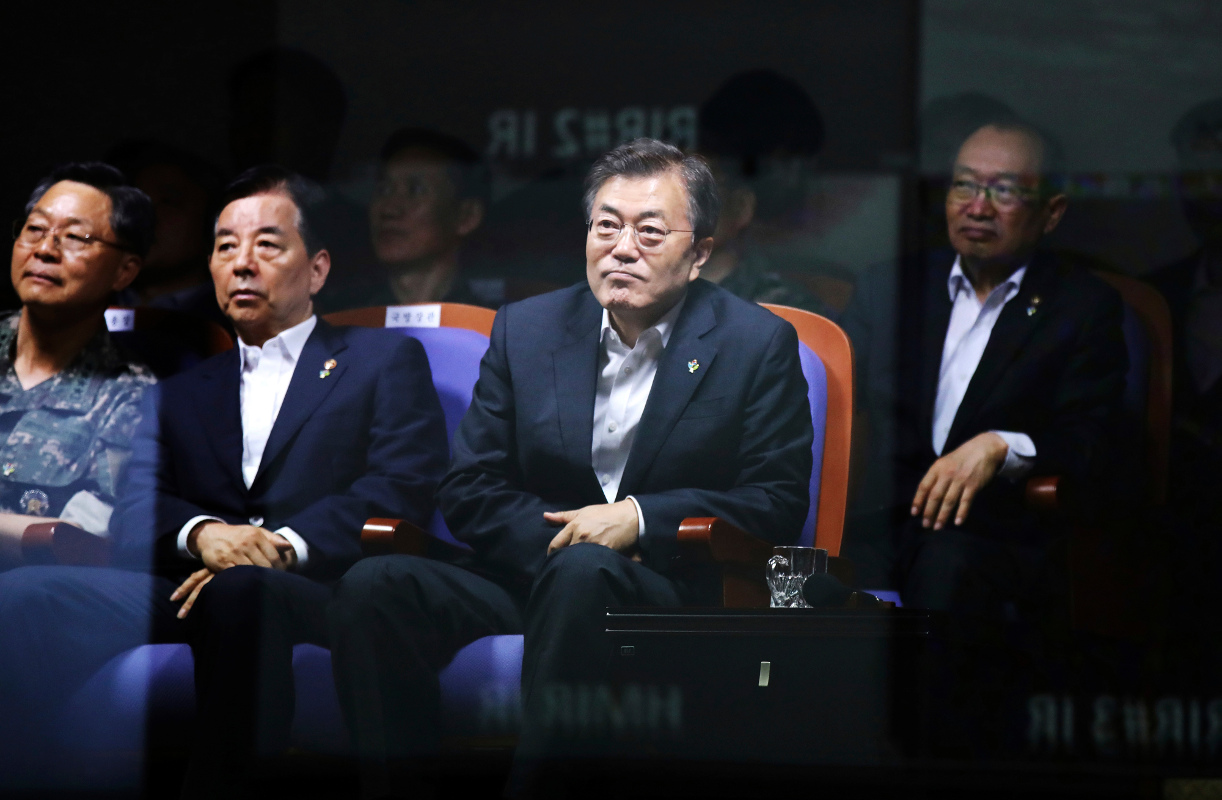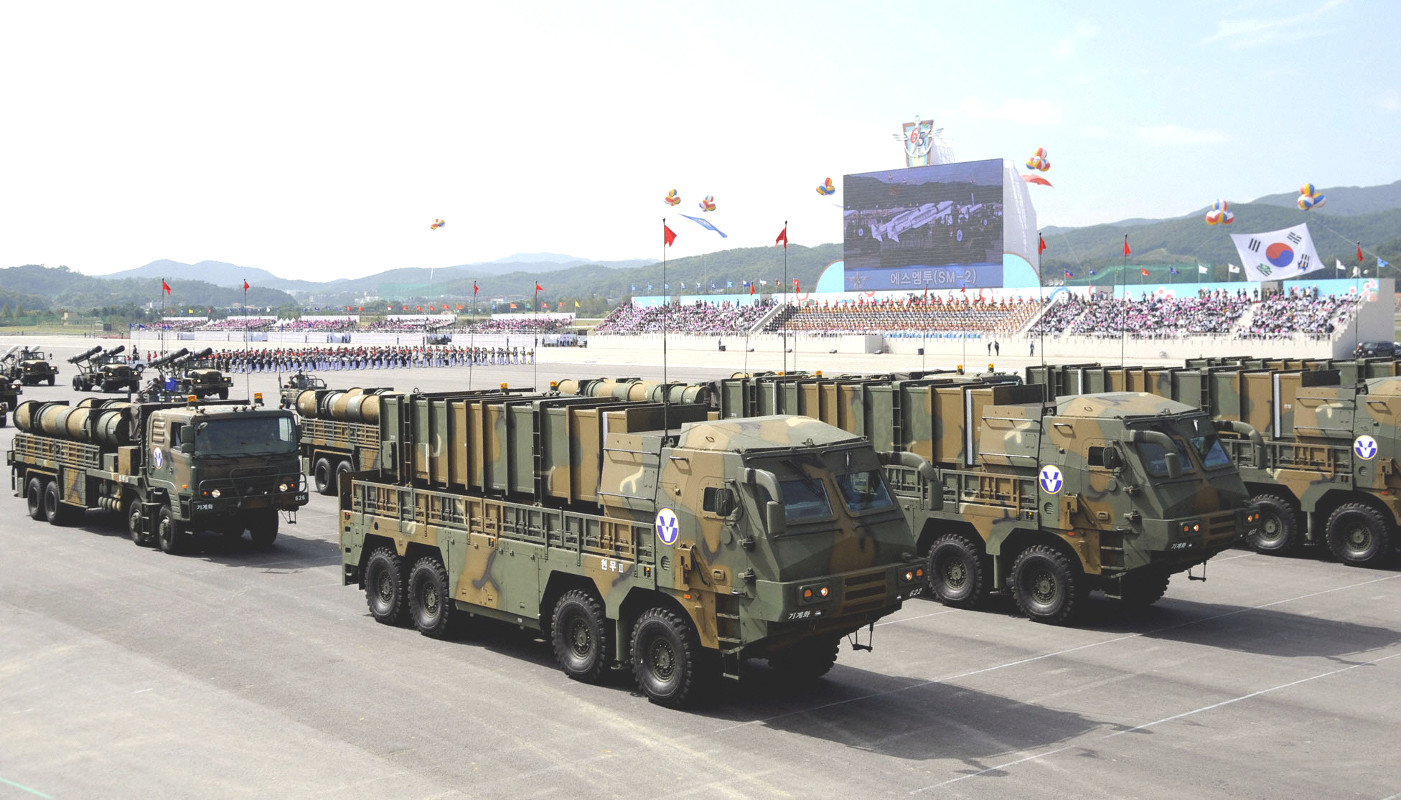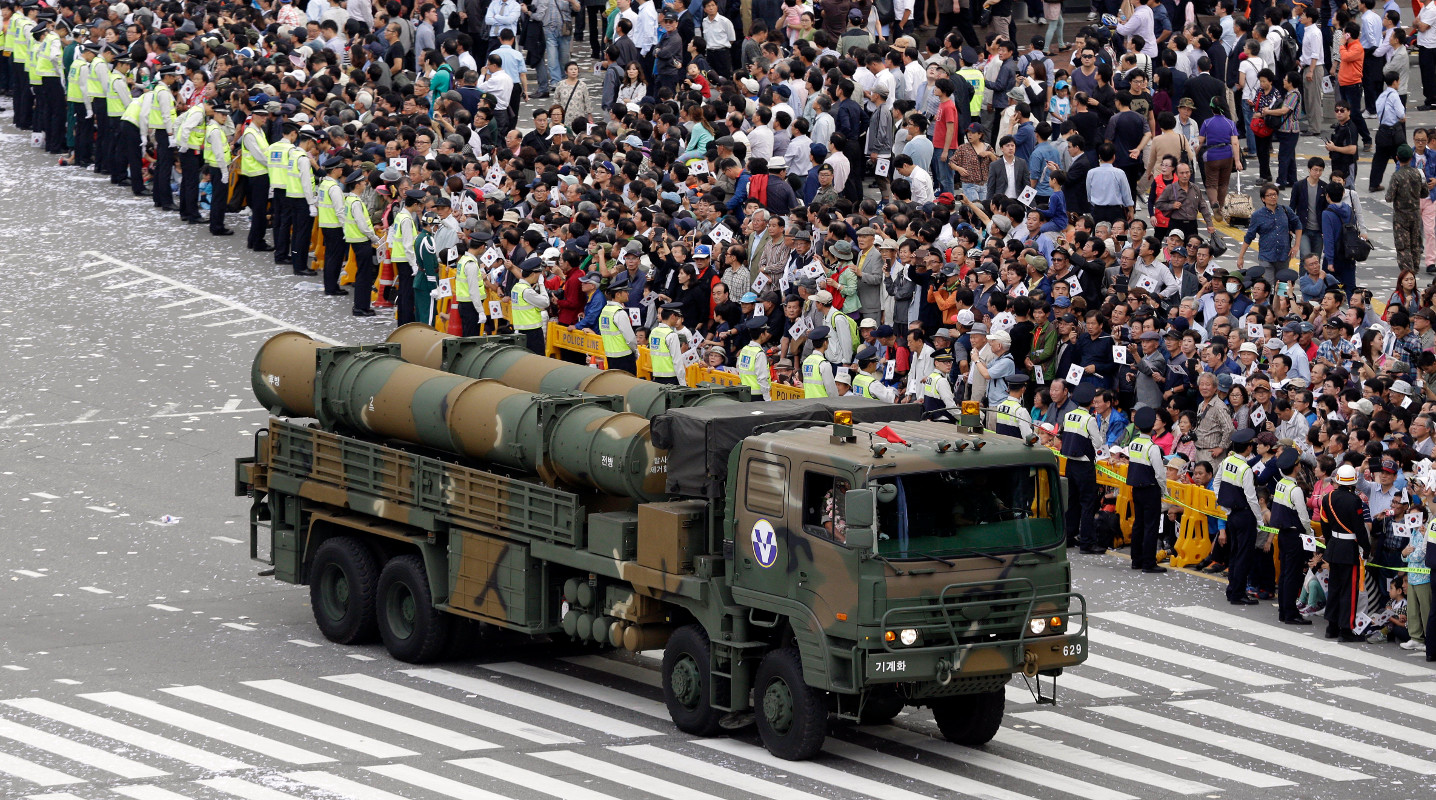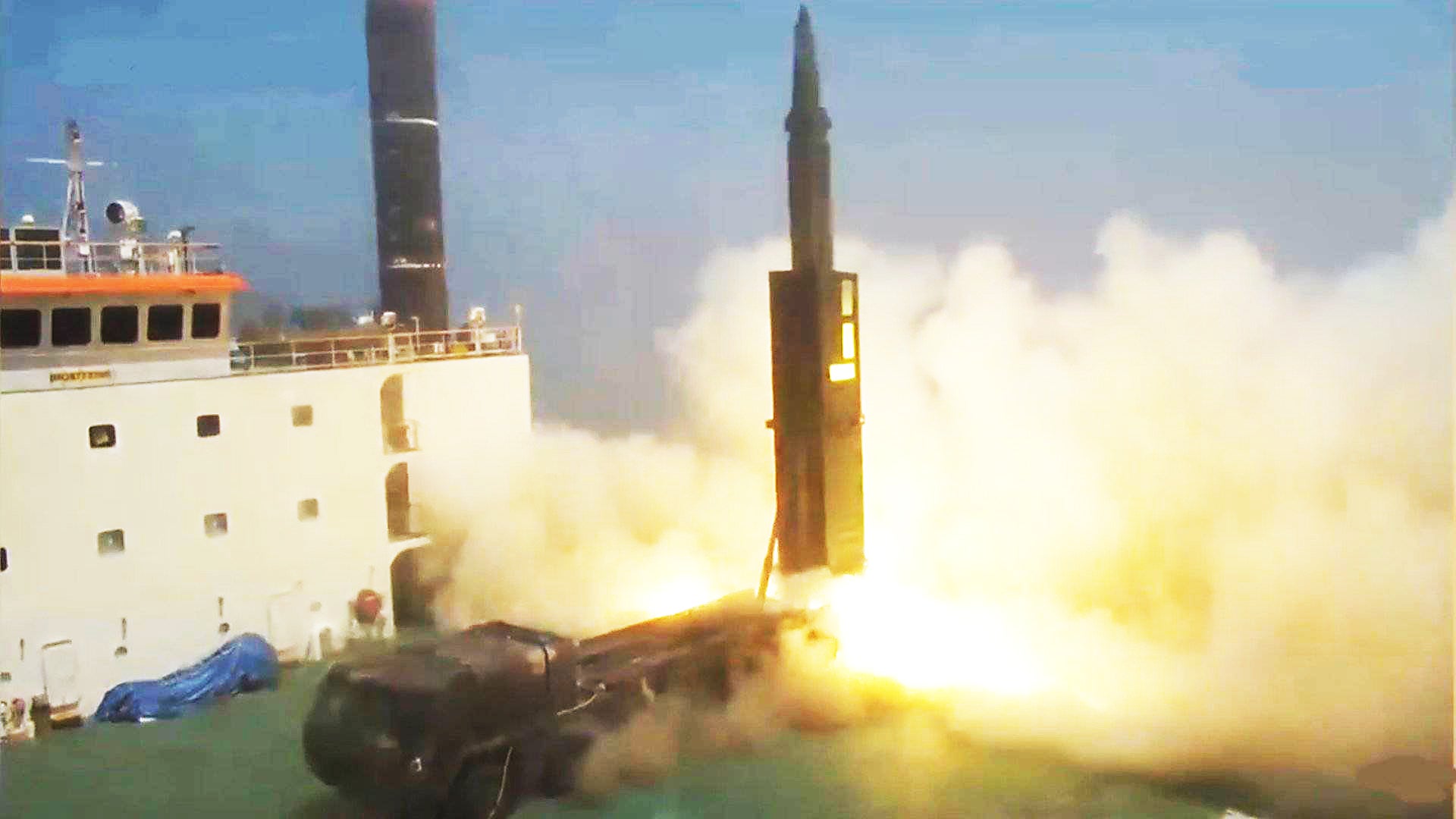South Korea has successfully fired a fourth prototype Hyunmoo-2C short-range ballistic missile, which can reach any target in North Korea. The country’s new President Moon Jae-in lauded the test, which follows months of North Korean missile launches and escalating rhetoric on the Korean Peninsula, as in line with his administration’s foreign policy plans.
On June 23, 2017, the South Korean Agency for Defense Development (ADD) conducted the test at its own facility approximately 120 miles southwest of Seoul. Video of launch showed the system’s standard semi-containerized truck-mounted launcher onboard either a ship or a sea platform. ADD, the country’s state-run military research and development arm, has been responsible for developing the Hyunmoo family, which includes both ballistic and cruise missiles, since at least the late 1970s.
The Hyunmoo-2C “will be a key component in our kill chain to counter possible North Korean missile attacks,” Park Soo-hyun, a spokesman for President Moon’s office said after the launch. “The president’s inspection of the test firing was aimed at sending a clear warning against North Korea’s repeated provocations.”
Since Moon won a special election in May 2017, following the impeachment of former President Park Geun-hye, North Korea has test fired five ballistic missiles, including a successful launch of a new, elongated version of the BM-25 Musudan intermediate-range ballistic missile.

The prototype Hyunmoo-2C flew an unspecified distance before hitting its target at sea, according to South Korean officials. The missile’s maximum range is understood to be approximately 497 miles, which is the farthest it could go under an existing U.S.-South Korean missile limitation agreement.
In 1979, the United States agreed to share ballistic missile technology with its Korean ally in exchange for guarantees it would not exceed certain weight and range restrictions. This resulted in the Hyunmoo-1 ballistic missile, which South Korea derived from the American-made Nike Hercules surface-to-air missile. In the 1980s, the two parties renegotiated the terms of the agreement leading to the first versions of the Hyunmoo-2. The A model could fly 186 miles, while the B version had a range of 310 miles.
In 2012, the U.S. government agreed again to up the maximum allowable characteristics, resulting in the -2C with its nearly 500 mile range. The South Korean military says that it only needs two more successful test launches before it can declare the system operational. At that time, it will have a combat-ready ballistic missile with the ability to hit anywhere inside North Korea.

This new test may come as a surprise to many who saw Moon’s election victory as a clear path toward de-escalating tensions between North and South Korea. He is head of South Korea’s liberal Democratic Party, which had been responsible for the so-called “Sunshine Policy” in the 1990s. Critics slammed this policy, which included increased diplomatic and economic interaction with the North, as simply enabling the brutal, repressive Communist regime and Moon seems unlikely to adopt anything similar in the near future. Instead, his opinion seems to be that improved diplomacy with the government in Pyongyang requires the security a credible deterrent capability.
“I am a believer in dialogue, but I also know that dialogue is possible when we have a strong national defense,” the president, who served in the South Korean Army’s elite Special Forces during his mandatory conscription, said after the Hyunmoo-2C test. “A policy of embracing North Korea is possible when we have a defense capability that surpasses that of North Korea.”
“In that sense, I believe the weapons systems ADD is developing are the means to enable dialogue and peace, instead of means to destroy or kill, and so you well deserve to take pride in ensuring our security with the strength of science,” the president continued.

Regardless, it’s still not entirely clear how Hyunmoo-2C fits into that overall military posture. Though a ballistic missile with a conventional warhead could be useful for holding North Korea’s most remote military facilities and missile launch sites under threat, South Korea’s military can already do that with conventionally-armed cruise missiles. Seoul is not party to any deals with the United States or anyone else that limit the ranges of those low-flying weapons, either.
In development since at least 2010, the Hyunmoo-3C land attack cruise missile, seen as an analogue to the American Tomahawk, has nearly twice the range of the -2C ballistic missile. With truck-mounted and submarine launch capabilities, the South Korean military has a very credible second-strike capability in the event of a North Korean surprise attack. A further improved version reportedly in development, referred to as either Hyunmoo-3D or Hyunmoo-4, could have a range of up to 1,864 miles, giving the country a regional strike capability.

The War Zone has examined this issue in the past, when reported surfaced in 2016 that the South Korean Navy’s up-coming 3,000-ton Jangbogo III-class diesel-electric submarines might be able to fire variants of the Hyunmoo-2 in addition to the Hyunmoo-3. At the time, Tyler Rogoway wrote:
Still, why would South Korea really need this capability at all? It already has a conventional second-strike capability, via its submarine-launched cruise missiles, and the country is not a nuclear power. Plus, South Korea is already protected under America’s nuclear umbrella.
It is true that even a conventionally tipped ballistic missile is tougher to defend against and hits much harder than an air-breathing cruise missile. Maybe South Korea sees the capability as a unique conventional second-strike deterrent. after all, ballistic missiles are more capable than cruise missiles of destroying deeply-buried North Korean bunkers. This capability could make the North Korean regime more vulnerable to a decapitation strike. Then there’s the possibility that South Korea is baking future nuclear ambitions into its submarine designs.
As the North Korean nuclear threat grows, and as the American presidential campaign floats potential changes in America’s military presence in the region, South Korea could make a grand strategic pivot and begin developing its own nuclear weapons. The ability to slap a few nuclear warheads onto a ballistic missile and load them into an advanced, long-diving submarine is one very powerful way to independently deter a North Korean nuclear attack—with or without America’s nuclear umbrella overhead.
Whether or not it was true then, this latter point about South Korea moving away from complete reliance on America’s nuclear deterrent may be an increasingly important consideration now. Moon’s political platform includes a stated plan to adopt policies that served the country’s interest first and appears more than willing to be critical of the United States. In January 2017, he published a book that reportedly included a passage saying South Korea should learn to “say no to America.” On the campaign trail, he reiterated this point, say he would be the man to do just that if elected president.

Since taking office, Moon has already shown he can stand up to American officials, halting the deployment of additional Terminal High Altitude Air Defense (THAAD) ballistic missile defense systems pending a new environment review. A scandal had erupted after the country’s Ministry of National Defense allowed four more launchers into the country, deliberately declining to inform the president’s office of the move.
With all this in mind, and with North Korea rapidly expanding its own ballistic missile and nuclear weapons arsenals, Moon seems likely to continue supporting development of the Hyunmoo-2 series.
Contact the author: joe@thedrive.com
